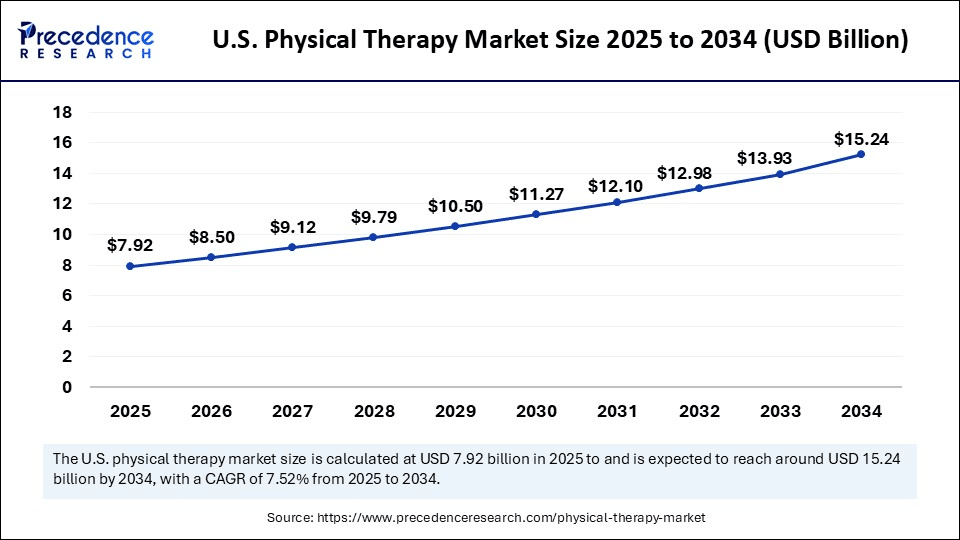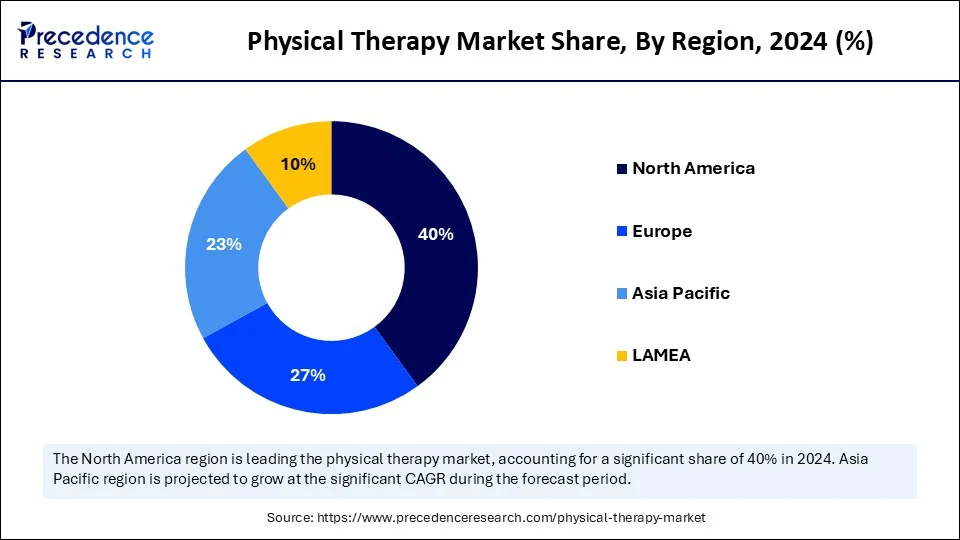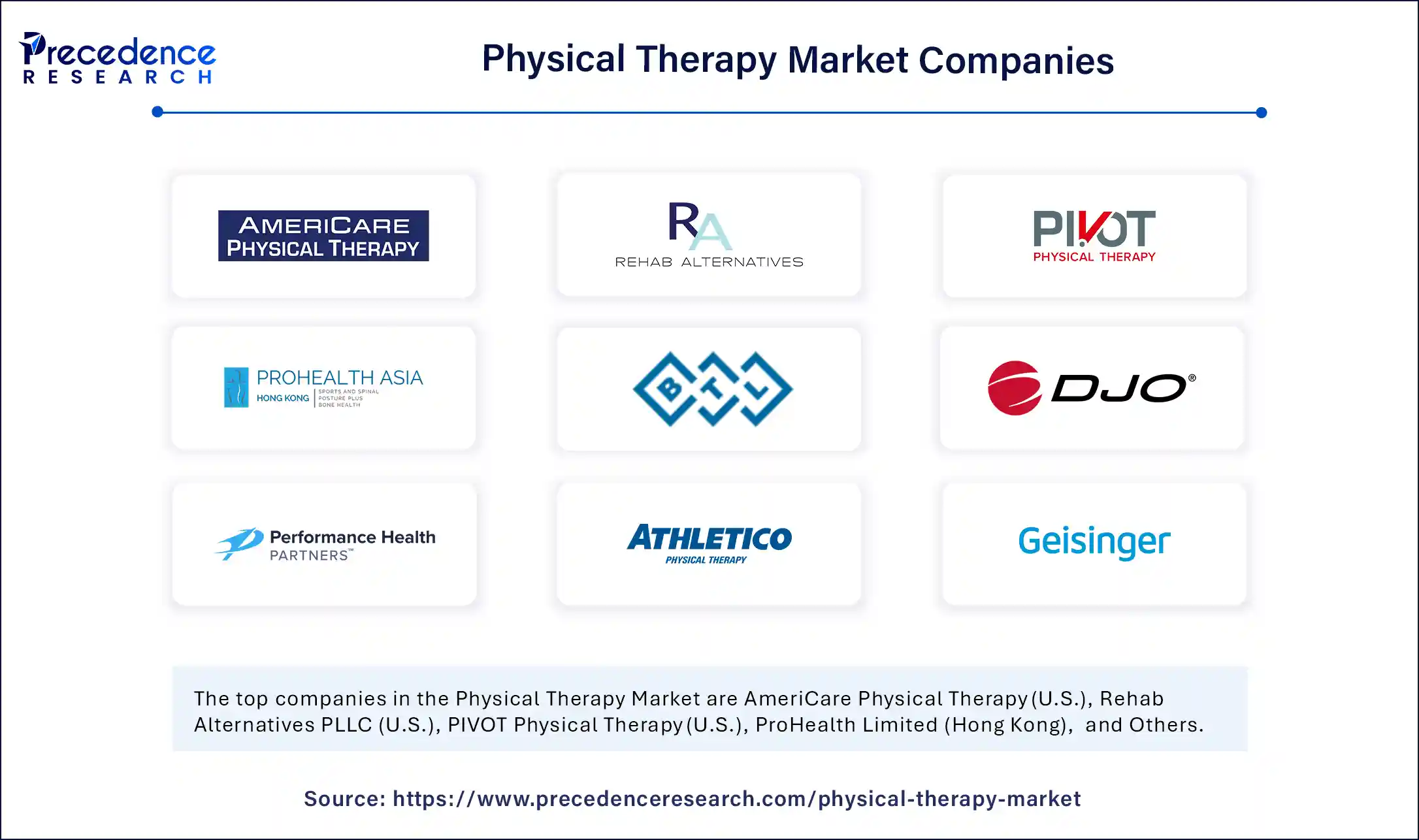What is the Physical Therapy Market Size?
The global physical therapy market size is valued at USD 26.04 billion in 2025 and is predicted to increase from USD 27.95 billion in 2026 to approximately USD 49.18 billion by 2034, expanding at a CAGR of 7.32% from 2025 to 2034. The growth of the market is attributed to the increasing awareness of musculoskeletal health, a growing geriatric population, and a rising demand for rehabilitation services following injury or surgery. As technology continues to integrate deeper into healthcare, innovations such as Artificial Intelligence (AI) are redefining traditional rehabilitation practices.

Physical Therapy Market Key Takeaways
- In terms of revenue, the physical therapy market was valued at USD 24.27 billion in 2024.
- It is projected to reach USD 49.18 billion by 2034.
- The market is expected to grow at a CAGR of 7.32% from 2025 to 2034.
- North America accounted for the major market share of 40% in 2024.
- Asia-Pacific is expected to expand at the highest CAGR in the coming years.
- By application, the orthopedic physical therapy segment held the largest market share in 2024.
- By application, the neurological physical therapy segment is expected to grow at the highest CAGR between 2025 and 2034.
- By age group, the adults segment held the largest market share in 2024.
- By age group, the elderly segment is expected to grow at the fastest rate in the coming years.
- By end-user, the hospitals segment dominated the market with the largest share in 2024.
- By end-user, the outpatient clinics segment is expected to grow at a significant CAGR between 2025 and 2034.
- By treatment procedure, the therapies segment held the largest market share in 2024.
- By treatment procedure, the equipment segment is expected to grow at a significant CAGR during the forecast period.
How is AI Reshaping the Future of the Physical Therapy Market?
Artificial Intelligence (AI) is revolutionizing the landscape of the physical therapy market by introducing smarter, data-driven, and personalized rehabilitation strategies. AI-powered platforms are now able to track patient progress in real-time, predict recovery timelines, and adjust therapy plans with precision. These systems use motion sensors, computer vision, and machine learning algorithms to monitor movements and provide instant feedback, significantly reducing the need for constant in-person supervision. Virtual physical therapy assistants and tele-rehab programmers are increasingly using AI to guide patients through exercises while ensuring correct posture and movement, improving outcomes and engagement.
AI also supports practitioners by analyzing large datasets to identify trends, detect anomalies early, and enhance diagnostic accuracy. This transformation not only optimizes treatment efficacy but also expands access to quality care, especially in remote or underserved regions. From robotic-assisted therapy to intelligent wearables that assess muscle activity, AI's integration into physical therapy helps create a more personalized, proactive, and scalable model of rehabilitation.
Market Overview
The global physical therapy market is experiencing significant growth, propelled by several key factors. One fundamental factor is the aging population, which is leading to a higher prevalence of chronic conditions, such as arthritis and stroke. Additionally, there has been a noticeable increase in health consciousness following the pandemic, prompting more individuals to seek preventive and therapeutic care. There has been a rising incidence of lifestyle-related injuries, largely attributed to sedentary habits and poor posture, common in our modern society. This further contributed to an escalating demand for physical therapy services.
The need for post-operative rehabilitation is particularly pronounced, especially in patients recovering from orthopedic and neurological surgeries, necessitating tailored therapeutic interventions. Moreover, the adoption of outpatient and home-based care models is on the rise, significantly boosting the demand for mobile physical therapy services. This shift not only enhances accessibility for patients but also aligns with the growing trend toward personalized care. Technological advances further propel the growth of the market. Innovations such as AI integration, virtual reality environments, and robotic rehabilitation systems are ushering in new methods of treatment, making therapy more effective and engaging for patients. Furthermore, increased insurance coverage for physiotherapy services, coupled with a growing public awareness of the importance of preventive healthcare, is solidifying physical therapy's role as a cornerstone of modern wellness strategies.
Key Market Trends
- Digital Health and Tele-Physiotherapy: The rise of telehealth platforms is enabling remote consultations, assessments, and guided therapy sessions. Patients now receive tailored exercise plans and real-time feedback through mobile apps and video conferencing tools, enhancing accessibility and compliance. This trend is especially valuable in rural and underserved regions, reducing the burden on physical clinics.
- AI and ML Integration: AI-driven tools are being employed for motion analysis, predictive recovery modeling, and automated progress tracking. Computer vision and wearable sensors allow precise evaluation of patient movements, correcting form and preventing injuries. Smart algorithms help clinicians optimize therapy plans, reducing recovery times and improving clinical outcomes.
- Wearable Technology and IoT in Rehabilitation: Devices such as smart braces, fitness trackers, and muscle stimulators are being integrated into rehabilitation protocols. These wearables collect continuous biomechanical and physiological data, aiding therapists in monitoring adherence and effectiveness.
Market Scope
| Report Coverage | Details |
| Market Size by 2034 | USD 49.18 Billion |
| Market Size in 2025 | USD 26.04 Billion |
| Market Size in 2026 | USD 27.95 Billion |
| Market Growth Rate from 2025 to 2034 | CAGR of 7.32% |
| Dominating Region | North America |
| Fastest Growing Region | Asia Pacific |
| Base Year | 2024 |
| Forecast Period | 2025 to 2034 |
| Segments Covered | Application, Age Group, End-User, Treatment Procedure, and Region |
| Regions Covered | North America, Europe, Asia-Pacific, Latin America, and Middle East & Africa |
Market Dynamics
Drivers
Rising Prevalence of Chronic Diseases
One of the major factors driving the growth of the physical therapy market is the rising prevalence of chronic and age-related conditions, such as osteoarthritis, cardiovascular diseases, and Parkinson's disease. These conditions often require physical therapy to reduce pain, strengthen muscles surrounding the joint, and enhance overall functional ability. As life expectancy increases globally, the demand for non-invasive, long-term rehabilitation solutions grows exponentially.Additionally, the rise in sports-related injuries and road accidents significantly boosts the need for physiotherapy services. Furthermore, increased awareness about physical health and immunity is leading to a spike in demand for preventive and restorative therapies. The rising integration of physical therapy into post-surgical recovery plans and chronic care management also solidifies its role as a cornerstone in modern healthcare.
Restraint
Shortage of Skilled Professionals and High Cost of Therapy
Despite its promising growth, the physical therapy market faces several challenges. One of the major restraining factors is the shortage of skilled physiotherapists, particularly in rural and low-income regions. This talent gap limits access and compromises the quality of care, especially as demand increases. Additionally, high costs associated with advanced rehabilitation equipment and therapies may hinder adoption in cost-sensitive regions. Limited insurance coverage or reimbursement for physiotherapy services in several countries also discourages patients from completing long-term therapy plans. Resistance to adopting digital health technologies, either due to a lack of awareness, limited digital literacy, or infrastructural gaps, can further slow market penetration. Finally, regulatory challenges, particularly around licensing, data privacy, and cross-border telehealth services, continue to pose obstacles for market players expanding globally.
Opportunity
Emerging Markets
The physical therapy market is brimming with opportunities, especially in emerging economies where healthcare infrastructure is rapidly developing. Rising disposable incomes, increasing health awareness, and government initiatives to improve healthcare access are opening doors for physiotherapists and digital health startups to penetrate these markets. Another promising opportunity lies in telerehabilitation and home-based care. As remote therapy gains traction, there is scope for developing user-friendly platforms that deliver personalized, interactive therapy experiences to patients in their own homes.
The growing awareness of fitness and wellness, especially among urban populations, also presents a unique opportunity for physical therapy to evolve from a curative to a preventive and lifestyle-oriented service. Moreover, collaborations between physiotherapists, sports clinics, orthopedic centers, and tech innovators are enabling interdisciplinary solutions that promise to redefine the rehabilitation experience. Franchise models and physiotherapy-as-a-service platforms are gaining momentum, especially in regions with high outpatient demand.
Application Insights
Why Did the Orthopedic Physical Therapy Segment Dominate the Market in 2024?
The orthopedic physical therapy segment dominated the market with the largest share in 2024. This is primarily due to the high prevalence of musculoskeletal disorders, sports injuries, and post-surgical rehabilitation needs. Conditions like arthritis, joint replacements, back pain, and fractures require structured rehabilitation plans for pain relief, mobility restoration, and muscle strengthening. Widespread awareness about early intervention, coupled with an aging population, has elevated the demand for evidence-based orthopedic physiotherapy. The segment's dominance is also reinforced due to advanced tools such as gait analysis, wearable sensors, and exoskeletons that offer real-time feedback and precision in movement correction.
On the other hand, the neurological physical therapy segment is expected to grow at the highest CAGR during the forecast period, driven by increasing cases of stroke, Parkinson's disease, spinal cord injuries, multiple sclerosis, and traumatic brain injuries. Neurological patients require long-term, continuous rehabilitation, making neurological physiotherapy particularly vital. Advancements in robot-assisted therapy, brain-computer interface devices, and AI-powered motion tracking are boosting recovery outcomes. Moreover, the increase in neuro-specialized outpatient services and public health programs for post-stroke rehabilitation contributes to segmental growth.
Age Insights
What Made Adults the Dominant Segment in the Physical Therapy Market?
The adults segment dominated the market with a major share in 2024 due to the increased prevalence of lifestyle-related musculoskeletal issues, occupational injuries, and increased participation in fitness and sports. Adults between 30–60 years are the primary seekers of physiotherapy for conditions like chronic back pain, tendonitis, ACL tears, and repetitive strain injuries. With the increased awareness of preventive wellness, adults are increasingly turning to physiotherapy for posture correction, pain management, and general fitness maintenance, bolstering segmental growth.
Meanwhile, the elderly segment is expected to grow at the fastest rate in the coming years, driven by rising life expectancy and the global increase in the number of cases of age-related conditions such as osteoporosis, arthritis, and neurodegenerative disorders. Older adults often require multifaceted therapy that combines mobility restoration, fall prevention, and chronic disease management. Increased focus on aging in place, assisted living communities with in-house physiotherapy services, and dedicated geriatric rehab programs are driving this growth. Moreover, caregivers and families are becoming more proactive about including physiotherapy in long-term elderly care plans.
End-User Insights
How Does the Hospitals Segment Dominate the Market in 2024?
The hospitals segment dominated the physical therapy market with the biggest share in 2024. This is mainly due to their comprehensive rehab infrastructure, skilled professionals, and access to multidisciplinary care. Physiotherapy is a standard part of inpatient and outpatient recovery, particularly for surgeries, strokes, and trauma cases. Hospitals are also early adopters of robotic devices, AI diagnostics, and integrated care pathways, allowing them to offer high-quality physiotherapy services. Moreover, patient trust, insurance tie-ups, and post-discharge follow-ups strengthen their market hold.
On the other hand, the outpatient clinics segment is expected to grow at a significant CAGR in the upcoming period. These clinics offer cost-effective, flexible, and accessible services for patients who prefer home-based or part-time care. Their popularity is driven by specialized offerings (e.g., sports rehab, neurological therapy), shorter waiting times, and the ability to use portable technologies and personalized care plans. Moreover, the growth of physiotherapy chains and franchises has made professional services more available to a wider demographic.
Treatment Insights
Why Did the Therapies Segment Dominate the Physical Therapy Market in 2024?
The therapies segment dominated the market with the maximum share in 2024 due to their proven effectiveness in managing several conditions. Therapies encompass manual therapy, exercise therapy, electrotherapy, and hydrotherapy. These therapies are foundational to rehabilitation, backed by strong clinical evidence and customizable to individual patient needs. Despite technological advances, therapies remain cost-effective, non-invasive, and highly versatile, making them suitable across a wide range of conditions, from orthopedic to neurological and cardiopulmonary rehabilitation.
Meanwhile, the equipment segment is expected to grow at a significant CAGR during the forecast period, driven by demand for technologically advanced tools like robotic exoskeletons, laser therapy units, virtual reality systems, and AI-integrated devices. Equipment enhances therapy precision, patient motivation, and recovery analytics, especially in chronic and neurological cases. With the rise in digital health adoption, physiotherapy clinics and hospitals are investing more in motion sensors, biofeedback systems, wearable rehabilitation gear, and home-based devices. The global shift toward data-driven healthcare is further fueling equipment adoption in physiotherapy practices.
Regional Insights
U.S. Physical Therapy Market Size and Growth 2025 to 2034
The U.S. physical therapy market size was exhibited at USD 7.92 billion in 2025 and is projected to be worth around USD 15.24 billion by 2034, growing at a CAGR of 7.52% from 2025 to 2034.

What Factors Contributed to North America's Dominance in the Physical Therapy Market?
North America dominated the market by holding the largest market share of 40% in 2024. This is mainly due to a well-established healthcare infrastructure, widespread awareness about physical rehabilitation, and a high prevalence of chronic and lifestyle-related disorders such as obesity, arthritis, and back pain. Robust insurance coverage for physiotherapy services under Medicare, Medicaid, and private insurers further bolstered the growth of the market. There is high adoption of advanced rehabilitation technologies, including AI-based assessment tools, wearable devices, and robotic therapy systems. A large pool of licensed physiotherapists and rehabilitation centers also contributed to the region's dominance.
The U.S. and Canada are major players in the North American physical therapy market. Strong government initiatives promoting physical wellness, injury recovery, and preventive care across different age groups support market growth. The U.S. is home to several major market players and digital health innovators, contributing to constant advancements and clinical integration. Additionally, increasing demand for home-based therapies and outpatient services is driving further expansion.

Asia Pacific Physical Therapy Market Trends
Asia Pacific is expected to grow at the fastest CAGR during the forecast period. The rising modernization of healthcare infrastructure, growing disposable incomes, and increasing awareness of the benefits of rehabilitative care are major factors driving the growth of the market in the region. The rising incidence of chronic diseases, driven by lifestyle changes and urbanization, is boosting the need for post-operative care. Government health initiatives in countries like India and China to expand public access to physiotherapy further supports regional market growth.
The rapid expansion of physiotherapy clinics, digital health platforms, and outpatient centers offering affordable, high-quality physical therapies boosts the growth of the market. There is a high demand for elderly and pediatric rehabilitation. Booming medical tourism, especially in Thailand, Malaysia, and India, where physiotherapy is a key post-surgery offering, also contributes to market expansion. Moreover, local tech startups are introducing affordable AI tools, mobile rehab apps, and wearable technologies, reshaping how physiotherapy is delivered across diverse populations.
European Physical Therapy Market Trends
Europe is considered to be a significantly growing area. The market within Europe is expanding due to an aging population and rising focus on holistic, non-pharmacological approaches to pain and mobility management. Countries like Germany, France, the UK, and the Nordic nations are leading the charge with expanding public health campaigns and increased funding for rehabilitation services. The growing elderly population, especially in Western Europe, is increasing the demand for long-term musculoskeletal and neurological rehabilitation.
Strong emphasis on physiotherapy as part of multidisciplinary care integrated into orthopedics, geriatrics, neurology, and sports medicine supports market expansion. The expansion of telerehabilitation platforms and AI-enabled diagnostics further opens up growth avenues. Government support for universal healthcare and physical therapy reimbursements under national health schemes and a strong focus on patient-centered wellness practices further drive the growth of the market.
Physical Therapy Market Companies

- AmeriCare Physical Therapy (U.S.)
- Rehab Alternatives PLLC (U.S.)
- PIVOT Physical Therapy (U.S.)
- ProHealth Limited (Hong Kong)
- BTL (India)
- DJO LLC (U.S.)
- Performance Health (U.S.)
- Athletico Physical Therapy (U.S.)
- Geisinger Health (U.S.)
- Select Medical Corporation (U.S.)
- Knight Health Holdings, LLC (U.S.)
- Concentra, Inc. (U.S.)
- EMS Physio Ltd. (U.K.)
- U.S. Physical Therapy, Inc. (U.S.)
- Isokinetics (U.S.)
Recent Development
- In May 2025, COACH! launched the first science-based fitness platform built specifically for surgeons and physical therapists. COACH! is strengthening the continuum of MSK care by providing expert guidance and Certified Coaching that bridges the gap between rehab and peak performance.
(Source:https://www.businesswire.com)
- In February 2024, SportsMed Physical Therapy announced the launch of its new core service offering: SportsMed HomeCare. This new service provides in-home outpatient physical therapy, speech therapy, and occupational therapy services to homebound patients.
(Source:https://ians.in)
Segments Covered in the Report
By Application
- Orthopedic Physical Therapy
- Geriatric Physical Therapy
- Neurological Physical Therapy
- Cardiopulmonary and Pulmonary Physical Therapy
- Others
By Age Group
- Pediatrics
- Adults
- Elderly
By End-User
- Hospitals
- Private Practices
- Outpatient Clinics
- Sports and Fitness Facility Centers
- Others
By Treatment Procedure
- Equipment
- Therapies
- Products
By Region
- North America
- Europe
- Asia Pacific
- Latin America
- MEA
For inquiries regarding discounts, bulk purchases, or customization requests, please contact us at sales@precedenceresearch.com
Frequently Asked Questions
Ask For Sample
No cookie-cutter, only authentic analysis – take the 1st step to become a Precedence Research client
 sales@precedenceresearch.com
sales@precedenceresearch.com
 +1 804-441-9344
+1 804-441-9344